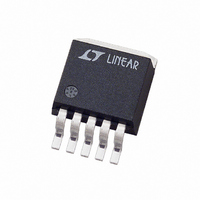LT1764AEQ-3.3#PBF Linear Technology, LT1764AEQ-3.3#PBF Datasheet - Page 11

LT1764AEQ-3.3#PBF
Manufacturer Part Number
LT1764AEQ-3.3#PBF
Description
IC LDO LOW NOISE 3A 3.3V DDPAK-5
Manufacturer
Linear Technology
Datasheet
1.LT1764AEQPBF.pdf
(20 pages)
Specifications of LT1764AEQ-3.3#PBF
Regulator Topology
Positive Fixed
Voltage - Output
3.3V
Voltage - Input
Up to 20V
Voltage - Dropout (typical)
0.34V @ 3A
Number Of Regulators
1
Current - Output
3A
Current - Limit (min)
3.1A
Operating Temperature
-40°C ~ 125°C
Mounting Type
Surface Mount
Package / Case
TO-263-5, D²Pak (5 leads + Tab), TO-263BA
Primary Input Voltage
20V
Output Voltage Fixed
3.3V
Dropout Voltage Vdo
340mV
No. Of Pins
5
Output Current
3A
Operating Temperature Range
-40°C To +125°C
Msl
MSL 1 - Unlimited
Rohs Compliant
Yes
Lead Free Status / RoHS Status
Lead free / RoHS Compliant
Available stocks
Company
Part Number
Manufacturer
Quantity
Price
APPLICATIO S I FOR ATIO
The LT1764A series are 3A low dropout regulators opti-
mized for fast transient response. The devices are capable
of supplying 3A at a dropout voltage of 340mV. The low
operating quiescent current (1mA) drops to less than 1µA
in shutdown. In addition to the low quiescent current, the
LT1764A regulators incorporate several protection fea-
tures which make them ideal for use in battery-powered
systems. The devices are protected against both reverse
input and reverse output voltages. In battery backup
applications where the output can be held up by a backup
battery when the input is pulled to ground, the LT1764A-X
acts like it has a diode in series with its output and prevents
reverse current flow. Additionally, in dual supply applica-
tions where the regulator load is returned to a negative
supply, the output can be pulled below ground by as much
as 20V and still allow the device to start and operate.
Adjustable Operation
The adjustable version of the LT1764A has an output
voltage range of 1.21V to 20V. The output voltage is set by
the ratio of two external resistors as shown in Figure 2. The
device servos the output to maintain the voltage at the ADJ
pin at 1.21V referenced to ground. The current in R1 is
then equal to 1.21V/R1 and the current in R2 is the current
in R1 plus the ADJ pin bias current. The ADJ pin bias
current, 3µA at 25°C, flows through R2 into the ADJ pin.
The output voltage can be calculated using the formula in
Figure 2. The value of R1 should be less than 4.17k to
minimize errors in the output voltage caused by the ADJ
pin bias current. Note that in shutdown the output is turned
off and the divider current will be zero.
The adjustable device is tested and specified with the ADJ
pin tied to the OUT pin for an output voltage of 1.21V.
Specifications for output voltages greater than 1.21V will
be proportional to the ratio of the desired output voltage to
1.21V: V
output current change of 1mA to 3A is – 3mV typical at
V
OUT
(5V/1.21V)(–3mV) = – 12.4mV
= 1.21V. At V
OUT
/1.21V. For example, load regulation for an
OUT
U
= 5V, load regulation is:
U
W
U
Output Capacitors and Stability
The LT1764A regulator is a feedback circuit. Like any
feedback circuit, frequency compensation is needed to
make it stable. For the LT1764A, the frequency compensa-
tion is both internal and external—the output capacitor.
The size of the output capacitor, the type of the output
capacitor, and the ESR of the particular output capacitor all
affect the stability.
In addition to stability, the output capacitor also affects the
high frequency transient response. The regulator loop has
a finite band width. For high frequency transient loads,
recovery from a transient is a combination of the output
capacitor and the bandwidth of the regulator. The
LT1764A was designed to be easy to use and accept a
wide variety of output capacitors. However, the frequency
compensation is affected by the output capacitor and
optimum frequency stability may require some ESR, espe-
cially with ceramic capacitors.
For ease of use, low ESR polytantalum capacitors (POSCAP)
are a good choice for both the transient response and
stability of the regulator. These capacitors have intrinsic
ESR that improves the stability. Ceramic capacitors have
extremely low ESR, and while they are a good choice in
many cases, placing a small series resistance element will
sometimes achieve optimum stability and minimize ring-
ing. In all cases, a minimum of 10µF is required while the
maximum ESR allowable is 3Ω.
The place where ESR is most helpful with ceramics is low
output voltage. At low output voltages, below 2.5V, some
ESR helps the stability when ceramic output capacitors
are used. Also, some ESR allows a smaller capacitor
value to be used. When small signal ringing occurs with
ceramics due to insufficient ESR, adding ESR or increas-
V
IN
IN
LT1764A
GND
OUT
ADJ
Figure 2. Adjustable Operation
R2
R1
1764 F02
+
V
OUT
LT1764A Series
V
V
I
OUTPUT RANGE = 1.21V TO 20V
ADJ
OUT
ADJ
=
=
=
3
1 21
1 21 1
µ AT 25 C
.
.
A
V
V
⎛
⎜
⎝
+
°
R
R
2
1
⎞
⎟ +
⎠
(
11
I
ADJ
1764afb
)( )
R
2












